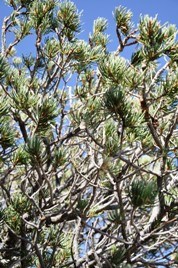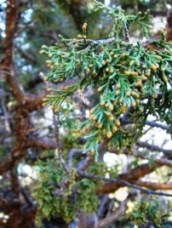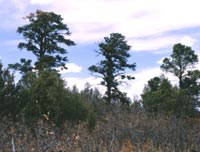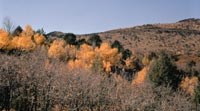
NPS A. BUCCANERO 
NPS A. BUCCANERO Pinyon pine is found throughout the monument, from the slopes of the volcano to the base and surrounding area. The monument's high elevation and low annual precipitation create a well-suited habitat for the pinyons that thrive in arid conditions. The pinyon serves the volcano in providing a sturdy root base that slows the steep slopes' rate of erosion. For wildlife, the trees' seeds are an important food source for birds, squirrels, deer, and even bear. Native Americans also utilized the seeds in their diet, and the tree's sap for basket and jewlrey making. As the state tree of New Mexico, the pinyon has and continues to be a sustenance-providing and iconic part of life in the southwest. 
NPS A. BUCCANERO Juniper grows alongside the pinyon pine at Capulin Volcano. Two species exist within the monument, the one-seed juniper (Juniperus monosperma) and the Rocky Mountain juniper (Juniperus scopulorum). Junipers have tight, scaly leaves that are compact to the branch and bark that has a shredded appearance. The juniper berry, light blue and pea-sized, is actually the plant's cone, and has been known to be used as a flavoring for cooking and tea. Junipers can grow up to 40 feet high, but growth is very slow and depends on the amount of water and nutrients available. The resiliency of the juniper is shown in especially dry, sloping land; the gnarled and twisted shape of the tree is a result of too little water. 
NPS photo 
NPS photo
Vegetation mapping is an ongoing project in the monument. A checklist of trees and shrubs found in Capulin Volcano National Monument was done in 2002 by the New Mexico Natural Heritage Program.
|
Last updated: April 24, 2025
